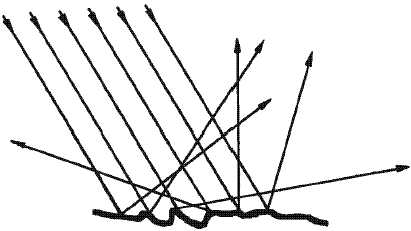1-31
speeds in different transparent substances. For example, water never appears as deep as it really is, and
objects under water appear to be closer to the surface than they really are. A bending of the light rays
causes these impressions.
Another example of refraction is the apparent bending of a spoon when it is immersed in a cup of
water. The bending seems to take place at the surface of the water, or exactly at the point where there is a
change of density. Obviously, the spoon does not bend from the pressure of the water. The light forming
the image of the spoon is bent as it passes from the water (a medium of high density) to the air (a medium
of comparatively low density).
Without refraction, light waves would pass in straight lines through transparent substances without
any change of direction. Refer back to figure 1-10, which shows refraction of a wave. As you can see, all
rays striking the glass at any angle other than perpendicular are refracted. However, the perpendicular ray,
which enters the glass normal to the surface, continues through the glass and into the air in a straight line
no refraction takes place.
Diffusion of Light
When light is reflected from a mirror, the angle of reflection of each ray equals the angle of
incidence. When light is reflected from a piece of plain white paper, however, the reflected beam is
scattered, or DIFFUSED, as shown in figure 1-21. Because the surface of the paper is not smooth, the
reflected light is broken up into many light beams that are reflected in all directions.
Figure 1-21.—Diffusion of light.
Absorption of Light
You have just seen that a light beam is reflected and diffused when it falls onto a piece of white
paper. If a light beam falls onto a piece of black paper, the black paper absorbs most of the light rays and
very little light is reflected from the paper. If the surface on which the light beam falls is perfectly black,
there is no reflection; that is, the light is totally absorbed. No matter what kind of surface light falls on,
however, some of the light is absorbed.
Q40. A light wave enters a sheet of glass at a perfect right angle to the surface. Is the majority of the
wave reflected, refracted, transmitted, or absorbed?
Q41. When light strikes a piece of white paper, the light is reflected in all directions. What do we call
this scattering of light?


